Critical Appraisal of a Research Article on Obesity and Depression
VerifiedAdded on 2023/03/17
|7
|2129
|32
Report
AI Summary
This report provides a critical appraisal of a research article investigating the correlation between obesity and depression among adolescents. The student analyzes the study's methodology, including its quantitative positivist research philosophy, deductive approach, data collection methods (household surveys, questionnaires, and interviews), and sampling design. The appraisal examines the strengths and weaknesses of the study design, data analysis, and findings, including the use of odds ratios to determine the relationship between depression and body weight. The report also discusses the study's conclusion that depression and obesity are positively correlated, highlighting the limitations, such as the non-community-based sample and the absence of weight-related stigma measurement. The student concludes that the study is well-structured and properly follows research steps, offering valuable insights into the association between obesity and depression among adolescents.

Running head: CRITICAL APPRAISAL
Critical Appraisal
Name of the Student
Name of the University
Author Note
Critical Appraisal
Name of the Student
Name of the University
Author Note
Paraphrase This Document
Need a fresh take? Get an instant paraphrase of this document with our AI Paraphraser
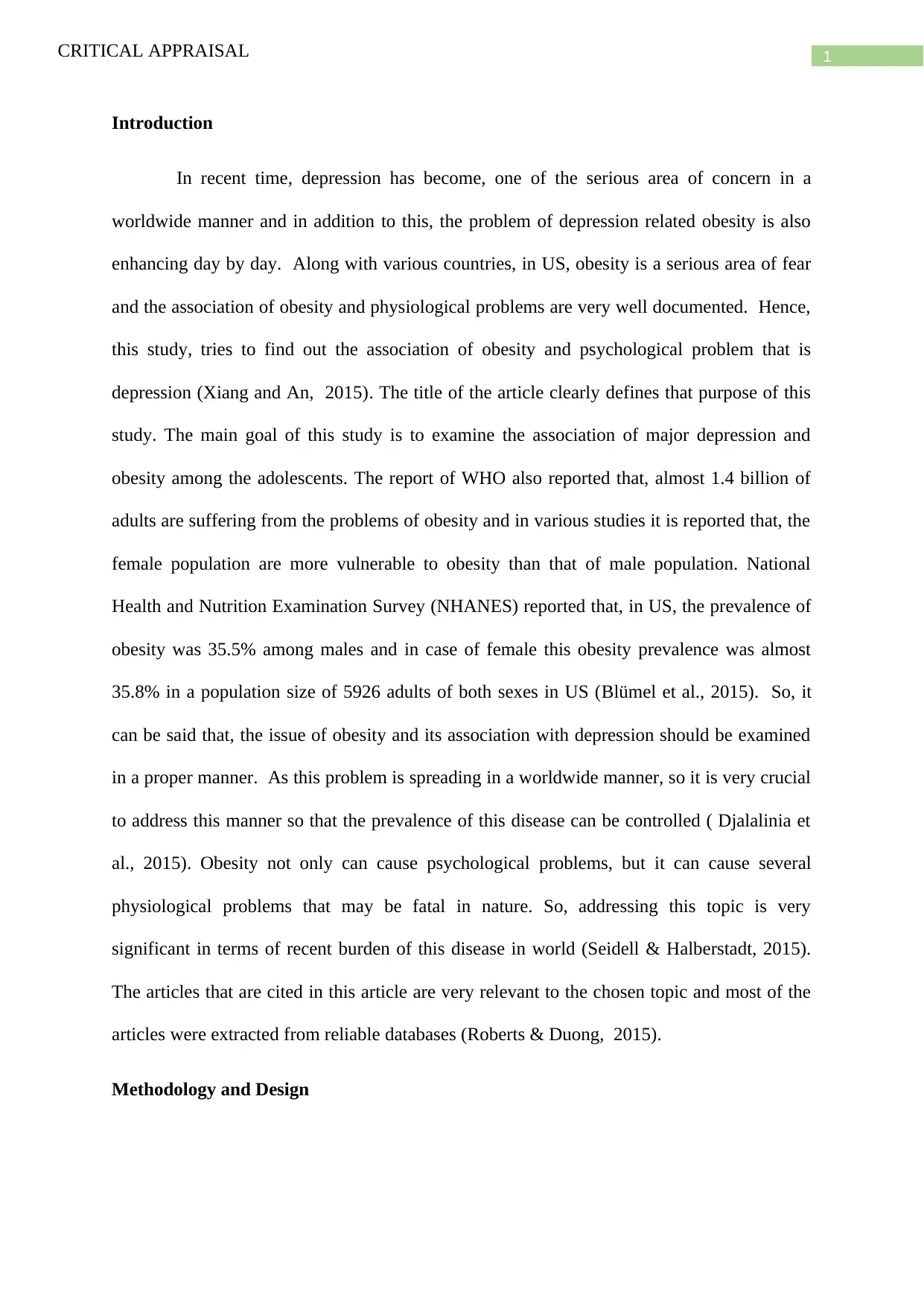
1CRITICAL APPRAISAL
Introduction
In recent time, depression has become, one of the serious area of concern in a
worldwide manner and in addition to this, the problem of depression related obesity is also
enhancing day by day. Along with various countries, in US, obesity is a serious area of fear
and the association of obesity and physiological problems are very well documented. Hence,
this study, tries to find out the association of obesity and psychological problem that is
depression (Xiang and An, 2015). The title of the article clearly defines that purpose of this
study. The main goal of this study is to examine the association of major depression and
obesity among the adolescents. The report of WHO also reported that, almost 1.4 billion of
adults are suffering from the problems of obesity and in various studies it is reported that, the
female population are more vulnerable to obesity than that of male population. National
Health and Nutrition Examination Survey (NHANES) reported that, in US, the prevalence of
obesity was 35.5% among males and in case of female this obesity prevalence was almost
35.8% in a population size of 5926 adults of both sexes in US (Blümel et al., 2015). So, it
can be said that, the issue of obesity and its association with depression should be examined
in a proper manner. As this problem is spreading in a worldwide manner, so it is very crucial
to address this manner so that the prevalence of this disease can be controlled ( Djalalinia et
al., 2015). Obesity not only can cause psychological problems, but it can cause several
physiological problems that may be fatal in nature. So, addressing this topic is very
significant in terms of recent burden of this disease in world (Seidell & Halberstadt, 2015).
The articles that are cited in this article are very relevant to the chosen topic and most of the
articles were extracted from reliable databases (Roberts & Duong, 2015).
Methodology and Design
Introduction
In recent time, depression has become, one of the serious area of concern in a
worldwide manner and in addition to this, the problem of depression related obesity is also
enhancing day by day. Along with various countries, in US, obesity is a serious area of fear
and the association of obesity and physiological problems are very well documented. Hence,
this study, tries to find out the association of obesity and psychological problem that is
depression (Xiang and An, 2015). The title of the article clearly defines that purpose of this
study. The main goal of this study is to examine the association of major depression and
obesity among the adolescents. The report of WHO also reported that, almost 1.4 billion of
adults are suffering from the problems of obesity and in various studies it is reported that, the
female population are more vulnerable to obesity than that of male population. National
Health and Nutrition Examination Survey (NHANES) reported that, in US, the prevalence of
obesity was 35.5% among males and in case of female this obesity prevalence was almost
35.8% in a population size of 5926 adults of both sexes in US (Blümel et al., 2015). So, it
can be said that, the issue of obesity and its association with depression should be examined
in a proper manner. As this problem is spreading in a worldwide manner, so it is very crucial
to address this manner so that the prevalence of this disease can be controlled ( Djalalinia et
al., 2015). Obesity not only can cause psychological problems, but it can cause several
physiological problems that may be fatal in nature. So, addressing this topic is very
significant in terms of recent burden of this disease in world (Seidell & Halberstadt, 2015).
The articles that are cited in this article are very relevant to the chosen topic and most of the
articles were extracted from reliable databases (Roberts & Duong, 2015).
Methodology and Design
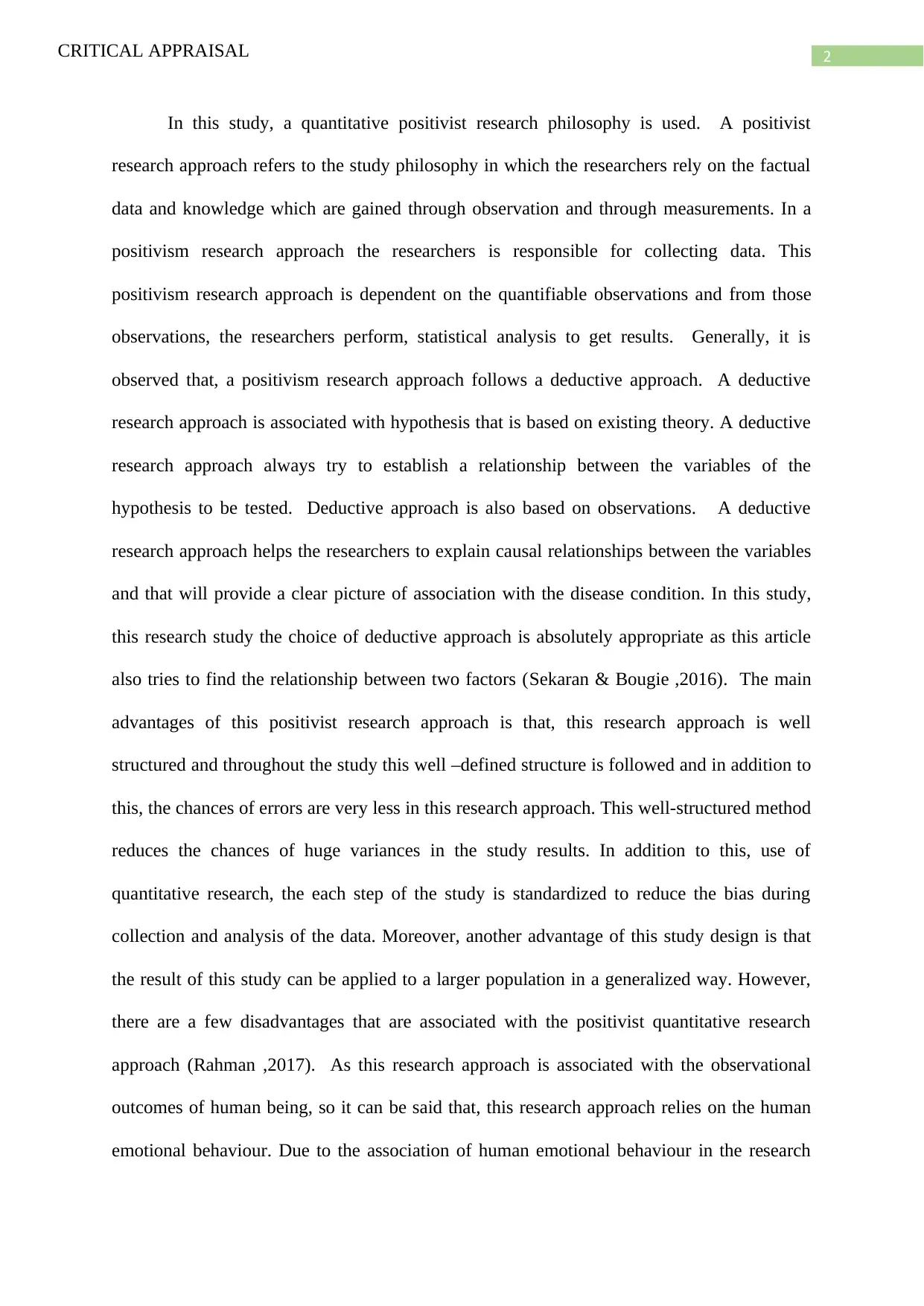
2CRITICAL APPRAISAL
In this study, a quantitative positivist research philosophy is used. A positivist
research approach refers to the study philosophy in which the researchers rely on the factual
data and knowledge which are gained through observation and through measurements. In a
positivism research approach the researchers is responsible for collecting data. This
positivism research approach is dependent on the quantifiable observations and from those
observations, the researchers perform, statistical analysis to get results. Generally, it is
observed that, a positivism research approach follows a deductive approach. A deductive
research approach is associated with hypothesis that is based on existing theory. A deductive
research approach always try to establish a relationship between the variables of the
hypothesis to be tested. Deductive approach is also based on observations. A deductive
research approach helps the researchers to explain causal relationships between the variables
and that will provide a clear picture of association with the disease condition. In this study,
this research study the choice of deductive approach is absolutely appropriate as this article
also tries to find the relationship between two factors (Sekaran & Bougie ,2016). The main
advantages of this positivist research approach is that, this research approach is well
structured and throughout the study this well –defined structure is followed and in addition to
this, the chances of errors are very less in this research approach. This well-structured method
reduces the chances of huge variances in the study results. In addition to this, use of
quantitative research, the each step of the study is standardized to reduce the bias during
collection and analysis of the data. Moreover, another advantage of this study design is that
the result of this study can be applied to a larger population in a generalized way. However,
there are a few disadvantages that are associated with the positivist quantitative research
approach (Rahman ,2017). As this research approach is associated with the observational
outcomes of human being, so it can be said that, this research approach relies on the human
emotional behaviour. Due to the association of human emotional behaviour in the research
In this study, a quantitative positivist research philosophy is used. A positivist
research approach refers to the study philosophy in which the researchers rely on the factual
data and knowledge which are gained through observation and through measurements. In a
positivism research approach the researchers is responsible for collecting data. This
positivism research approach is dependent on the quantifiable observations and from those
observations, the researchers perform, statistical analysis to get results. Generally, it is
observed that, a positivism research approach follows a deductive approach. A deductive
research approach is associated with hypothesis that is based on existing theory. A deductive
research approach always try to establish a relationship between the variables of the
hypothesis to be tested. Deductive approach is also based on observations. A deductive
research approach helps the researchers to explain causal relationships between the variables
and that will provide a clear picture of association with the disease condition. In this study,
this research study the choice of deductive approach is absolutely appropriate as this article
also tries to find the relationship between two factors (Sekaran & Bougie ,2016). The main
advantages of this positivist research approach is that, this research approach is well
structured and throughout the study this well –defined structure is followed and in addition to
this, the chances of errors are very less in this research approach. This well-structured method
reduces the chances of huge variances in the study results. In addition to this, use of
quantitative research, the each step of the study is standardized to reduce the bias during
collection and analysis of the data. Moreover, another advantage of this study design is that
the result of this study can be applied to a larger population in a generalized way. However,
there are a few disadvantages that are associated with the positivist quantitative research
approach (Rahman ,2017). As this research approach is associated with the observational
outcomes of human being, so it can be said that, this research approach relies on the human
emotional behaviour. Due to the association of human emotional behaviour in the research
⊘ This is a preview!⊘
Do you want full access?
Subscribe today to unlock all pages.

Trusted by 1+ million students worldwide
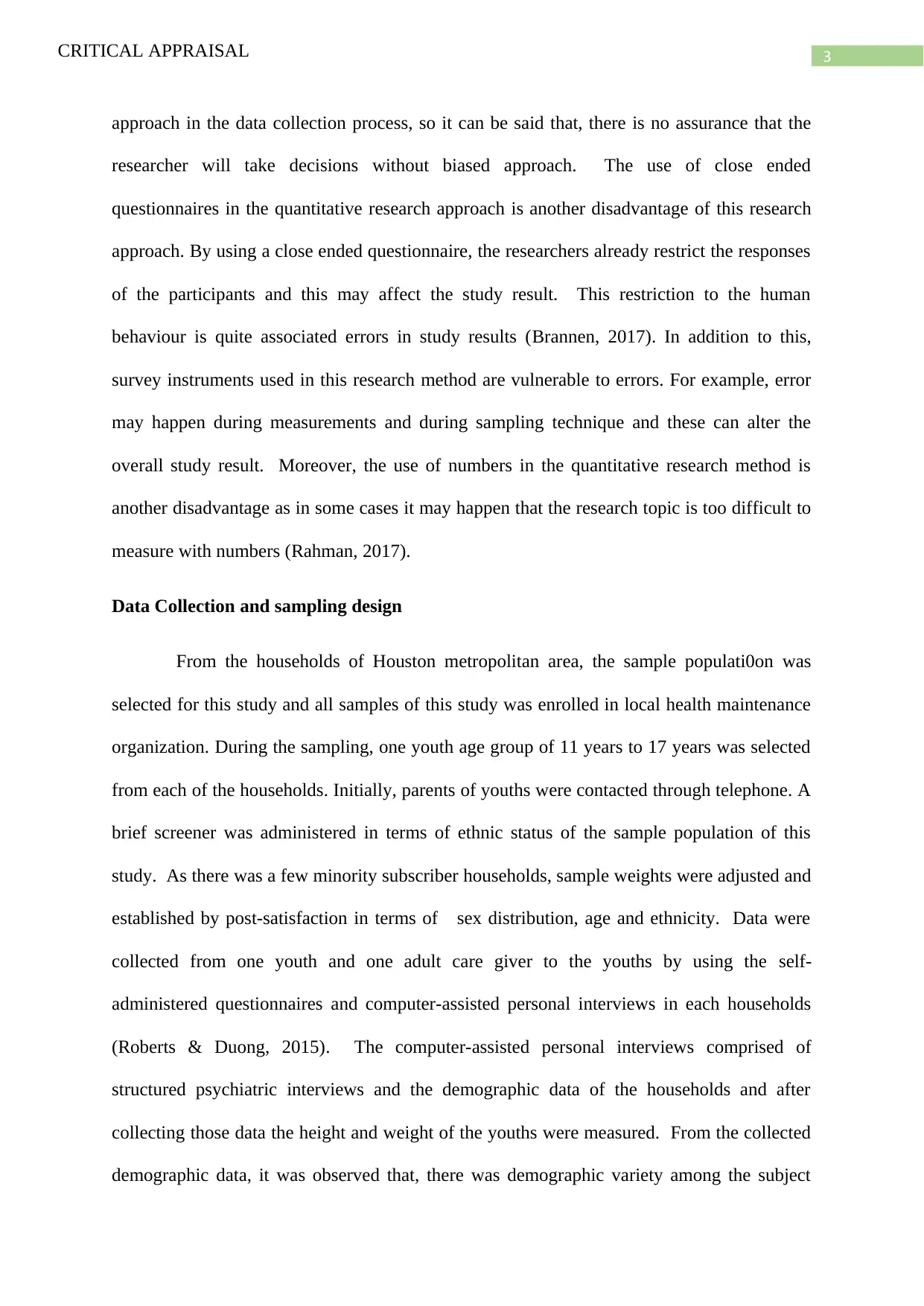
3CRITICAL APPRAISAL
approach in the data collection process, so it can be said that, there is no assurance that the
researcher will take decisions without biased approach. The use of close ended
questionnaires in the quantitative research approach is another disadvantage of this research
approach. By using a close ended questionnaire, the researchers already restrict the responses
of the participants and this may affect the study result. This restriction to the human
behaviour is quite associated errors in study results (Brannen, 2017). In addition to this,
survey instruments used in this research method are vulnerable to errors. For example, error
may happen during measurements and during sampling technique and these can alter the
overall study result. Moreover, the use of numbers in the quantitative research method is
another disadvantage as in some cases it may happen that the research topic is too difficult to
measure with numbers (Rahman, 2017).
Data Collection and sampling design
From the households of Houston metropolitan area, the sample populati0on was
selected for this study and all samples of this study was enrolled in local health maintenance
organization. During the sampling, one youth age group of 11 years to 17 years was selected
from each of the households. Initially, parents of youths were contacted through telephone. A
brief screener was administered in terms of ethnic status of the sample population of this
study. As there was a few minority subscriber households, sample weights were adjusted and
established by post-satisfaction in terms of sex distribution, age and ethnicity. Data were
collected from one youth and one adult care giver to the youths by using the self-
administered questionnaires and computer-assisted personal interviews in each households
(Roberts & Duong, 2015). The computer-assisted personal interviews comprised of
structured psychiatric interviews and the demographic data of the households and after
collecting those data the height and weight of the youths were measured. From the collected
demographic data, it was observed that, there was demographic variety among the subject
approach in the data collection process, so it can be said that, there is no assurance that the
researcher will take decisions without biased approach. The use of close ended
questionnaires in the quantitative research approach is another disadvantage of this research
approach. By using a close ended questionnaire, the researchers already restrict the responses
of the participants and this may affect the study result. This restriction to the human
behaviour is quite associated errors in study results (Brannen, 2017). In addition to this,
survey instruments used in this research method are vulnerable to errors. For example, error
may happen during measurements and during sampling technique and these can alter the
overall study result. Moreover, the use of numbers in the quantitative research method is
another disadvantage as in some cases it may happen that the research topic is too difficult to
measure with numbers (Rahman, 2017).
Data Collection and sampling design
From the households of Houston metropolitan area, the sample populati0on was
selected for this study and all samples of this study was enrolled in local health maintenance
organization. During the sampling, one youth age group of 11 years to 17 years was selected
from each of the households. Initially, parents of youths were contacted through telephone. A
brief screener was administered in terms of ethnic status of the sample population of this
study. As there was a few minority subscriber households, sample weights were adjusted and
established by post-satisfaction in terms of sex distribution, age and ethnicity. Data were
collected from one youth and one adult care giver to the youths by using the self-
administered questionnaires and computer-assisted personal interviews in each households
(Roberts & Duong, 2015). The computer-assisted personal interviews comprised of
structured psychiatric interviews and the demographic data of the households and after
collecting those data the height and weight of the youths were measured. From the collected
demographic data, it was observed that, there was demographic variety among the subject
Paraphrase This Document
Need a fresh take? Get an instant paraphrase of this document with our AI Paraphraser
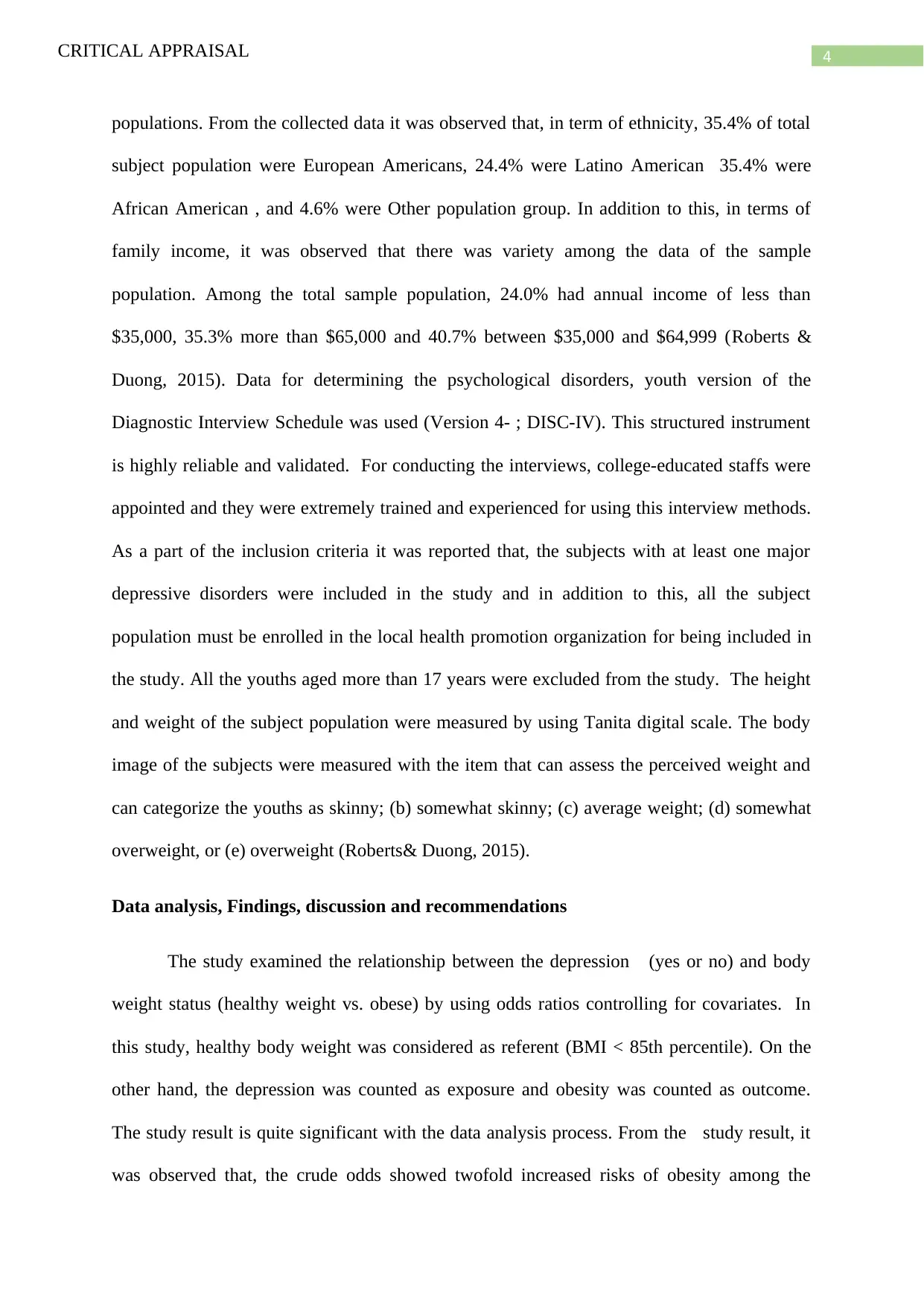
4CRITICAL APPRAISAL
populations. From the collected data it was observed that, in term of ethnicity, 35.4% of total
subject population were European Americans, 24.4% were Latino American 35.4% were
African American , and 4.6% were Other population group. In addition to this, in terms of
family income, it was observed that there was variety among the data of the sample
population. Among the total sample population, 24.0% had annual income of less than
$35,000, 35.3% more than $65,000 and 40.7% between $35,000 and $64,999 (Roberts &
Duong, 2015). Data for determining the psychological disorders, youth version of the
Diagnostic Interview Schedule was used (Version 4- ; DISC-IV). This structured instrument
is highly reliable and validated. For conducting the interviews, college-educated staffs were
appointed and they were extremely trained and experienced for using this interview methods.
As a part of the inclusion criteria it was reported that, the subjects with at least one major
depressive disorders were included in the study and in addition to this, all the subject
population must be enrolled in the local health promotion organization for being included in
the study. All the youths aged more than 17 years were excluded from the study. The height
and weight of the subject population were measured by using Tanita digital scale. The body
image of the subjects were measured with the item that can assess the perceived weight and
can categorize the youths as skinny; (b) somewhat skinny; (c) average weight; (d) somewhat
overweight, or (e) overweight (Roberts& Duong, 2015).
Data analysis, Findings, discussion and recommendations
The study examined the relationship between the depression (yes or no) and body
weight status (healthy weight vs. obese) by using odds ratios controlling for covariates. In
this study, healthy body weight was considered as referent (BMI < 85th percentile). On the
other hand, the depression was counted as exposure and obesity was counted as outcome.
The study result is quite significant with the data analysis process. From the study result, it
was observed that, the crude odds showed twofold increased risks of obesity among the
populations. From the collected data it was observed that, in term of ethnicity, 35.4% of total
subject population were European Americans, 24.4% were Latino American 35.4% were
African American , and 4.6% were Other population group. In addition to this, in terms of
family income, it was observed that there was variety among the data of the sample
population. Among the total sample population, 24.0% had annual income of less than
$35,000, 35.3% more than $65,000 and 40.7% between $35,000 and $64,999 (Roberts &
Duong, 2015). Data for determining the psychological disorders, youth version of the
Diagnostic Interview Schedule was used (Version 4- ; DISC-IV). This structured instrument
is highly reliable and validated. For conducting the interviews, college-educated staffs were
appointed and they were extremely trained and experienced for using this interview methods.
As a part of the inclusion criteria it was reported that, the subjects with at least one major
depressive disorders were included in the study and in addition to this, all the subject
population must be enrolled in the local health promotion organization for being included in
the study. All the youths aged more than 17 years were excluded from the study. The height
and weight of the subject population were measured by using Tanita digital scale. The body
image of the subjects were measured with the item that can assess the perceived weight and
can categorize the youths as skinny; (b) somewhat skinny; (c) average weight; (d) somewhat
overweight, or (e) overweight (Roberts& Duong, 2015).
Data analysis, Findings, discussion and recommendations
The study examined the relationship between the depression (yes or no) and body
weight status (healthy weight vs. obese) by using odds ratios controlling for covariates. In
this study, healthy body weight was considered as referent (BMI < 85th percentile). On the
other hand, the depression was counted as exposure and obesity was counted as outcome.
The study result is quite significant with the data analysis process. From the study result, it
was observed that, the crude odds showed twofold increased risks of obesity among the
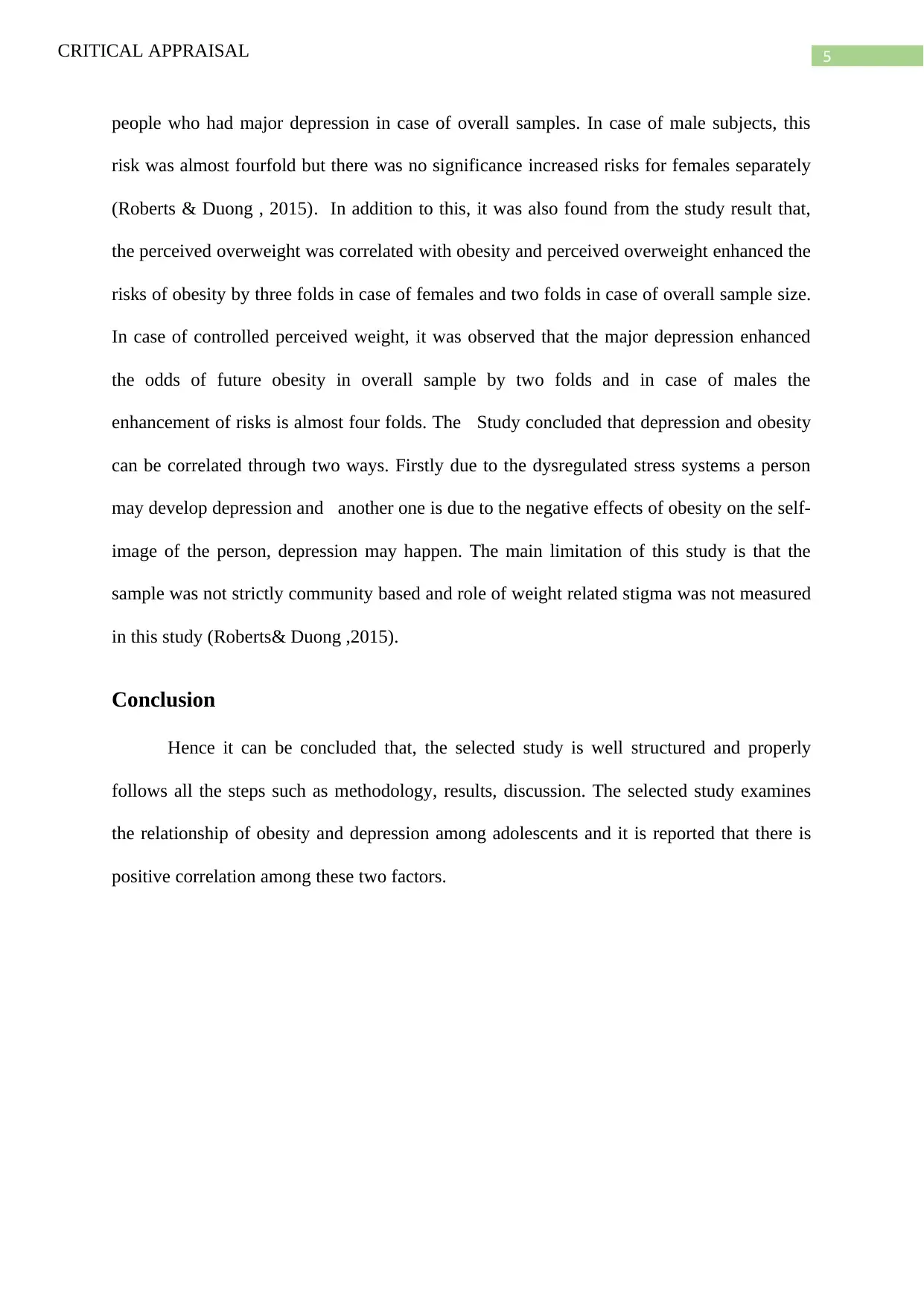
5CRITICAL APPRAISAL
people who had major depression in case of overall samples. In case of male subjects, this
risk was almost fourfold but there was no significance increased risks for females separately
(Roberts & Duong , 2015). In addition to this, it was also found from the study result that,
the perceived overweight was correlated with obesity and perceived overweight enhanced the
risks of obesity by three folds in case of females and two folds in case of overall sample size.
In case of controlled perceived weight, it was observed that the major depression enhanced
the odds of future obesity in overall sample by two folds and in case of males the
enhancement of risks is almost four folds. The Study concluded that depression and obesity
can be correlated through two ways. Firstly due to the dysregulated stress systems a person
may develop depression and another one is due to the negative effects of obesity on the self-
image of the person, depression may happen. The main limitation of this study is that the
sample was not strictly community based and role of weight related stigma was not measured
in this study (Roberts& Duong ,2015).
Conclusion
Hence it can be concluded that, the selected study is well structured and properly
follows all the steps such as methodology, results, discussion. The selected study examines
the relationship of obesity and depression among adolescents and it is reported that there is
positive correlation among these two factors.
people who had major depression in case of overall samples. In case of male subjects, this
risk was almost fourfold but there was no significance increased risks for females separately
(Roberts & Duong , 2015). In addition to this, it was also found from the study result that,
the perceived overweight was correlated with obesity and perceived overweight enhanced the
risks of obesity by three folds in case of females and two folds in case of overall sample size.
In case of controlled perceived weight, it was observed that the major depression enhanced
the odds of future obesity in overall sample by two folds and in case of males the
enhancement of risks is almost four folds. The Study concluded that depression and obesity
can be correlated through two ways. Firstly due to the dysregulated stress systems a person
may develop depression and another one is due to the negative effects of obesity on the self-
image of the person, depression may happen. The main limitation of this study is that the
sample was not strictly community based and role of weight related stigma was not measured
in this study (Roberts& Duong ,2015).
Conclusion
Hence it can be concluded that, the selected study is well structured and properly
follows all the steps such as methodology, results, discussion. The selected study examines
the relationship of obesity and depression among adolescents and it is reported that there is
positive correlation among these two factors.
⊘ This is a preview!⊘
Do you want full access?
Subscribe today to unlock all pages.

Trusted by 1+ million students worldwide
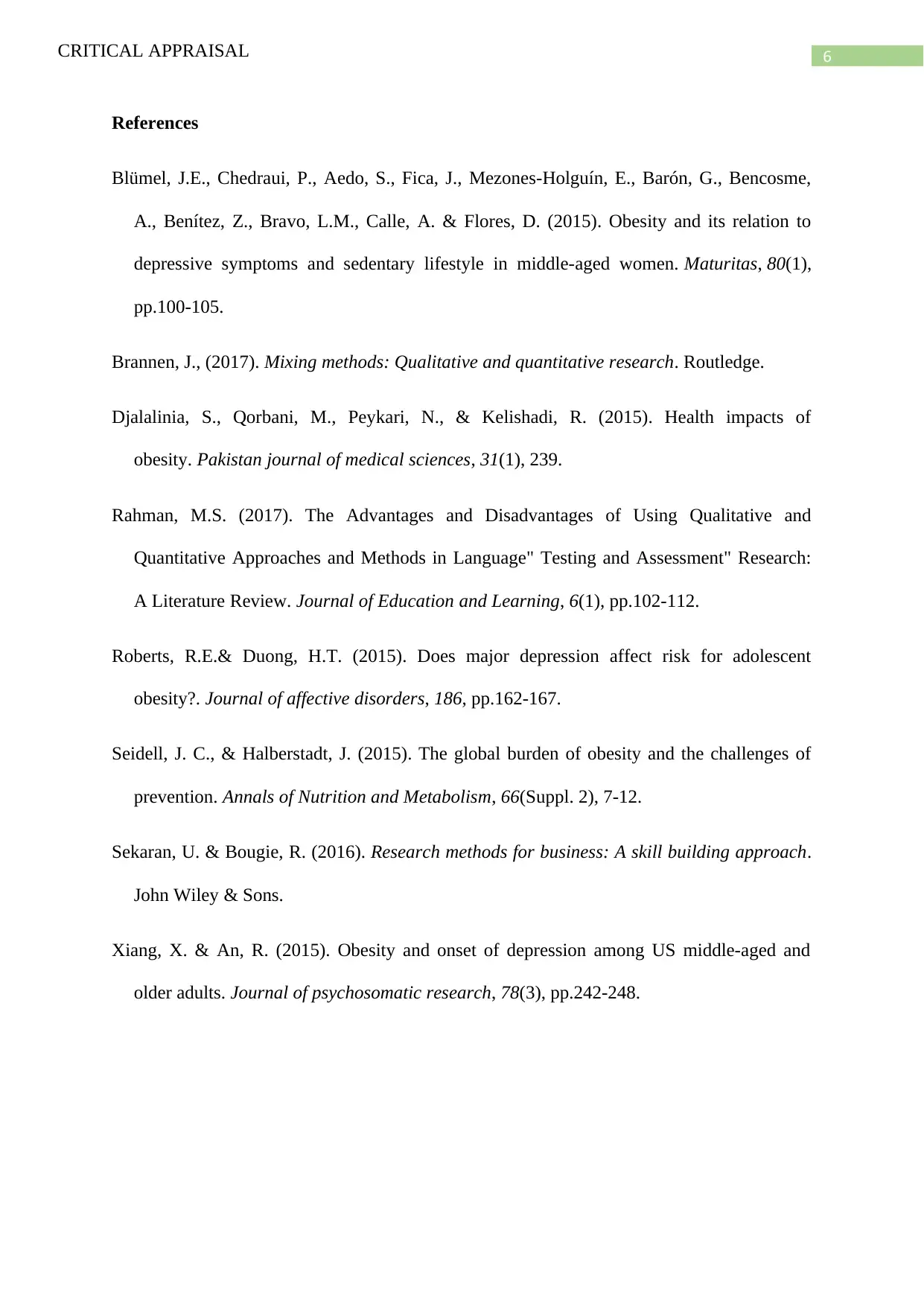
6CRITICAL APPRAISAL
References
Blümel, J.E., Chedraui, P., Aedo, S., Fica, J., Mezones-Holguín, E., Barón, G., Bencosme,
A., Benítez, Z., Bravo, L.M., Calle, A. & Flores, D. (2015). Obesity and its relation to
depressive symptoms and sedentary lifestyle in middle-aged women. Maturitas, 80(1),
pp.100-105.
Brannen, J., (2017). Mixing methods: Qualitative and quantitative research. Routledge.
Djalalinia, S., Qorbani, M., Peykari, N., & Kelishadi, R. (2015). Health impacts of
obesity. Pakistan journal of medical sciences, 31(1), 239.
Rahman, M.S. (2017). The Advantages and Disadvantages of Using Qualitative and
Quantitative Approaches and Methods in Language" Testing and Assessment" Research:
A Literature Review. Journal of Education and Learning, 6(1), pp.102-112.
Roberts, R.E.& Duong, H.T. (2015). Does major depression affect risk for adolescent
obesity?. Journal of affective disorders, 186, pp.162-167.
Seidell, J. C., & Halberstadt, J. (2015). The global burden of obesity and the challenges of
prevention. Annals of Nutrition and Metabolism, 66(Suppl. 2), 7-12.
Sekaran, U. & Bougie, R. (2016). Research methods for business: A skill building approach.
John Wiley & Sons.
Xiang, X. & An, R. (2015). Obesity and onset of depression among US middle-aged and
older adults. Journal of psychosomatic research, 78(3), pp.242-248.
References
Blümel, J.E., Chedraui, P., Aedo, S., Fica, J., Mezones-Holguín, E., Barón, G., Bencosme,
A., Benítez, Z., Bravo, L.M., Calle, A. & Flores, D. (2015). Obesity and its relation to
depressive symptoms and sedentary lifestyle in middle-aged women. Maturitas, 80(1),
pp.100-105.
Brannen, J., (2017). Mixing methods: Qualitative and quantitative research. Routledge.
Djalalinia, S., Qorbani, M., Peykari, N., & Kelishadi, R. (2015). Health impacts of
obesity. Pakistan journal of medical sciences, 31(1), 239.
Rahman, M.S. (2017). The Advantages and Disadvantages of Using Qualitative and
Quantitative Approaches and Methods in Language" Testing and Assessment" Research:
A Literature Review. Journal of Education and Learning, 6(1), pp.102-112.
Roberts, R.E.& Duong, H.T. (2015). Does major depression affect risk for adolescent
obesity?. Journal of affective disorders, 186, pp.162-167.
Seidell, J. C., & Halberstadt, J. (2015). The global burden of obesity and the challenges of
prevention. Annals of Nutrition and Metabolism, 66(Suppl. 2), 7-12.
Sekaran, U. & Bougie, R. (2016). Research methods for business: A skill building approach.
John Wiley & Sons.
Xiang, X. & An, R. (2015). Obesity and onset of depression among US middle-aged and
older adults. Journal of psychosomatic research, 78(3), pp.242-248.
1 out of 7
Related Documents
Your All-in-One AI-Powered Toolkit for Academic Success.
+13062052269
info@desklib.com
Available 24*7 on WhatsApp / Email
![[object Object]](/_next/static/media/star-bottom.7253800d.svg)
Unlock your academic potential
Copyright © 2020–2025 A2Z Services. All Rights Reserved. Developed and managed by ZUCOL.





